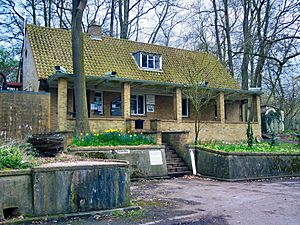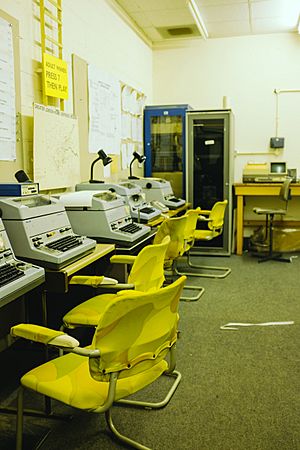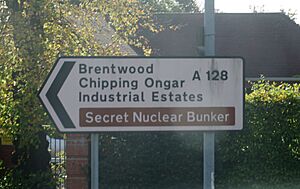Kelvedon Hatch Secret Nuclear Bunker facts for kids
The Kelvedon Hatch Secret Nuclear Bunker is a huge underground hideout in Kelvedon Hatch, Essex, England. It was kept ready during the Cold War to be a secret command center for the government. After it was closed in 1992, it became a cool museum. Now, you can visit and learn all about its important role during the Cold War.
Contents
Building the Secret Bunker
This amazing bunker has three levels and was first built in the 1950s. It was part of a big project called ROTOR by the Royal Air Force (RAF). Its first job was to be an air defense station, helping to protect Britain from air attacks.
Later, its purpose changed. During the Cold War, it became a secret place for the government to operate from if there was a nuclear attack. It was known as a 'Regional Seat of Government' (RSG) or 'Regional Government Headquarters' (RGHQ).
Why Was the Bunker Needed?
The bunker was designed to hold hundreds of military and government workers. If a nuclear war happened, these people would work from deep underground. Their job would be to help people survive and keep the government running. It was a very important place for national safety.
A Look Back at History
The Kelvedon Hatch bunker was built between 1952 and 1953. This was during the Cold War, a time when many countries were worried about nuclear war. The ROTOR program aimed to make Britain's air defenses stronger.
The bunker was a very strong, three-level center for RAF Fighter Command. It helped control air defense for the London area. From the 1960s until the early 1990s, the UK government used it as an emergency site.
From Secret Base to Museum
By the early 1990s, the threat of nuclear war had lessened. The bunker was no longer needed, so it was sold back to the family who owned the land before it was built. Today, it's a popular Cold War museum. Many of its original features from its secret days are still there for visitors to see.
Exploring Inside the Bunker
This bunker is buried about 125 feet (38 meters) underground! The entrance is hidden inside a normal-looking bungalow, which is a small house. From the bungalow, a 100-yard (91-meter) long tunnel leads you down to the lowest floor of the bunker.
The bunker has three main floors, with a large hill covering it and a radio mast nearby. It was built to keep hundreds of people safe for up to three months.
Life Underground
Imagine living underground for months! The bunker had everything needed:
- Air conditioning and heating to keep people comfortable.
- Its own water supply, both from the main system and a deep well.
- Generators to make electricity.
- Lots of radio and communication equipment. This included special systems to protect against electromagnetic pulses (EMP) from a nuclear blast. These systems helped the government stay in touch with different army groups and other important services.
The Bunker Today
In 1992, the bunker was officially closed. The land was returned to the Parrish family, who had owned it before. They turned it into the museum and tourist attraction we see today. It's quite funny that there are now brown tourist signs pointing everyone to the "Secret Nuclear Bunker"!
The Bunker on Screen
The Kelvedon Hatch bunker has also been used as a filming location:
- The BBC TV show Top Gear even featured the funny road signs.
- It was a key location for the TV show The Murder Game.
- An episode of New Tricks called "The Queen's Speech" was filmed there in 2014.
- The British horror film S.N.U.B! was filmed in the bunker in 2010.
- The 2016 video game The Bunker, which uses live-action video, was entirely filmed inside this amazing place.
Gallery
See also
- Central Government War Headquarters
- Civil Contingencies Secretariat
- Hack Green Secret Nuclear Bunker
- Wartime Broadcasting Service










